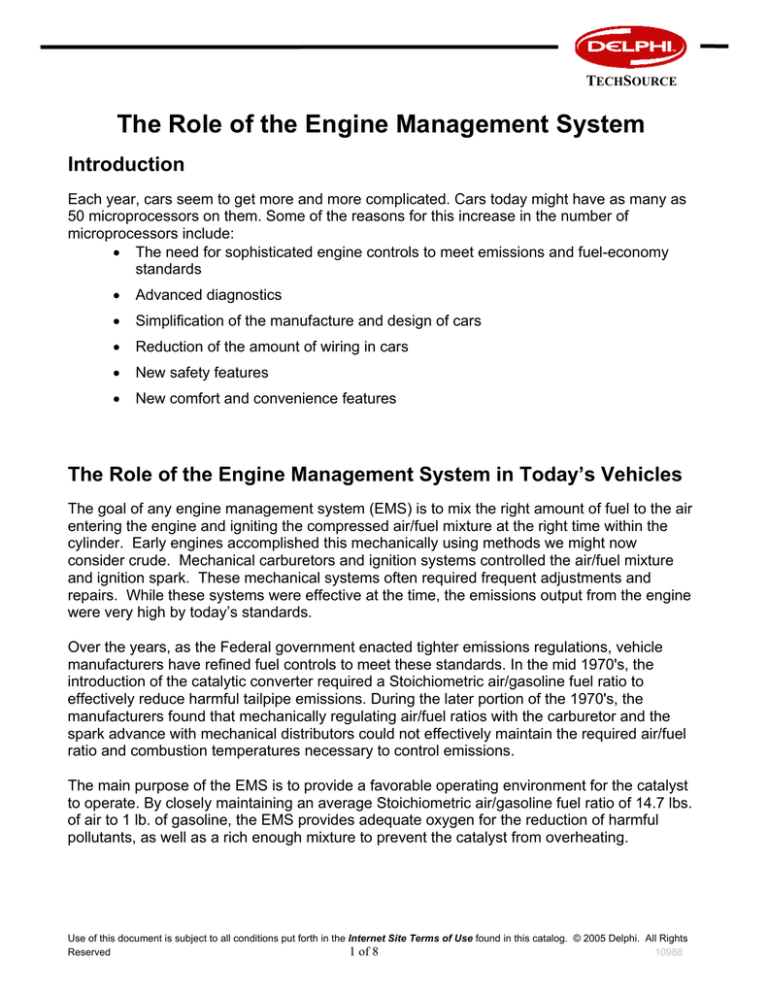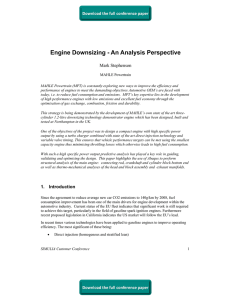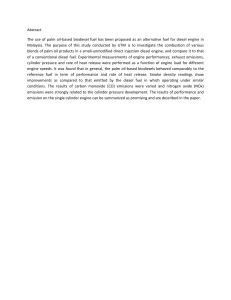
TECHSOURCE
The Role of the Engine Management System
Introduction
Each year, cars seem to get more and more complicated. Cars today might have as many as
50 microprocessors on them. Some of the reasons for this increase in the number of
microprocessors include:
• The need for sophisticated engine controls to meet emissions and fuel-economy
standards
•
Advanced diagnostics
•
Simplification of the manufacture and design of cars
•
Reduction of the amount of wiring in cars
•
New safety features
•
New comfort and convenience features
The Role of the Engine Management System in Today’s Vehicles
The goal of any engine management system (EMS) is to mix the right amount of fuel to the air
entering the engine and igniting the compressed air/fuel mixture at the right time within the
cylinder. Early engines accomplished this mechanically using methods we might now
consider crude. Mechanical carburetors and ignition systems controlled the air/fuel mixture
and ignition spark. These mechanical systems often required frequent adjustments and
repairs. While these systems were effective at the time, the emissions output from the engine
were very high by today’s standards.
Over the years, as the Federal government enacted tighter emissions regulations, vehicle
manufacturers have refined fuel controls to meet these standards. In the mid 1970's, the
introduction of the catalytic converter required a Stoichiometric air/gasoline fuel ratio to
effectively reduce harmful tailpipe emissions. During the later portion of the 1970's, the
manufacturers found that mechanically regulating air/fuel ratios with the carburetor and the
spark advance with mechanical distributors could not effectively maintain the required air/fuel
ratio and combustion temperatures necessary to control emissions.
The main purpose of the EMS is to provide a favorable operating environment for the catalyst
to operate. By closely maintaining an average Stoichiometric air/gasoline fuel ratio of 14.7 lbs.
of air to 1 lb. of gasoline, the EMS provides adequate oxygen for the reduction of harmful
pollutants, as well as a rich enough mixture to prevent the catalyst from overheating.
Use of this document is subject to all conditions put forth in the Internet Site Terms of Use found in this catalog. © 2005 Delphi. All Rights
Reserved
1 of 8
10988
TECHSOURCE
The Role of the Engine Management System in Today’s Vehicles
(continued)
Current fuel injected vehicles maintain tighter fuel control over a wide range of operating
conditions which not only controls emissions but also increased fuel economy. Carbureted
systems relied on either a mechanical or an electro/mechanical choke to richen the
air/gasoline fuel mixture during the warm-up period. Carbureted and early fuel injected
vehicles often did not reach closed-loop status until the entire powertrain was up to normal
operating temperatures. Advances and refinements to fuel injection technology and operating
strategies now allow the EMS to enter closed-loop long before the powertrain is at full
operating temperature. Due to the speed and accuracy of the EMS, a tight control over
emissions and economy can be maintained while still providing good performance. However,
the initial goal of the EMS is, and always will be to maintain emissions.
Because the fuel injection components are electrically interconnected, the EMS can maintain
faster and more precise control over output controls. The EMS capacity to take speedy
readings of inputs and perform faster calculations allows more responsive commands. More
efficient use of the powertrain is achieved due to the speed and accuracy that the EMS
monitors the airflow entering the engine as well as its physical properties.
Engine Systems Controlled by the EMS
The Engine Management System (EMS) can control various engine management systems
simultaneously creating an efficient way to maintain minimal emissions while enhancing the
fuel economy and performance. Almost all current vehicles utilize the EMS to control some or
all of the following engine systems:
•
Ignition System
•
Emissions Systems
•
Fuel System
•
Other Systems – Transmission, Heating, Ventilation, Air Conditioning (HVAC),
Steering, Braking
Use of this document is subject to all conditions put forth in the Internet Site Terms of Use found in this catalog. © 2005 Delphi. All Rights
Reserved
2 of 8
10988
TECHSOURCE
Engine Systems Controlled by the EMS (continued)
The input sensors are the keys to understanding how this type of system operates. These
signals inform the engine control module of the present operating conditions. The following
sensors may be used for spark timing calculations.
•
Throttle Position Sensor (TPS) - vehicle operator demand or view a change in
engine operating conditions
•
Manifold Absolute Pressure Sensor (MAP) - input engine load conditions and
typically will supply changes in altitude (BARO)
•
Mass Airflow Sensor (MAF) - input engine load conditions and typically will supply
changes in altitude (BARO)
•
Engine RPM - a critical input having a direct affect on when the spark must be
initiated
•
Engine Coolant Temperature (ECT) Sensor
•
Oxygen (O2) Sensor
Use of this document is subject to all conditions put forth in the Internet Site Terms of Use found in this catalog. © 2005 Delphi. All Rights
Reserved
3 of 8
10988
TECHSOURCE
A Look Inside the Computer
The heart of any Engine Management System (EMS) is the electronic control module, which
may be called the ECM or powertrain control module (PCM). Different manufacturers have
called it many different things also. For example, it has been called the ECU, ECA, Power
Module, Logic Module, etc. For simplicity, we will refer to the EMS computer as ECM/PCM.
The ECM/PCM typically contains three internal sections. First is the basic information area.
Here is where the unchanging data is contained. Some units call this the read only memory,
or ROM section. Here is where the computer switches components on or off, depending upon
the input from the sensors.
A second area contains the logic circuits, the
random access memory, or RAM. This is the
decision-making area of the computer. The
inputs are received, compared, calculated, etc.
and a decision is reached, which then triggers
a response from the ROM compartment. Since
each engine, drive train, carburetor or injection
system, and accessory combination has its
own specific requirements for operation, each
computer must be programmed for that specific
combination.
Within the computer, or attached to it, is the calibration unit. Some computers use a separate
programmable read only memory, or PROM unit. Others have this data contained within the
computer itself. This unit contains the engine size and type, operating temperatures, spark
advance information, basic timing, and fuel mixture requirements for all operating ranges.
Use of this document is subject to all conditions put forth in the Internet Site Terms of Use found in this catalog. © 2005 Delphi. All Rights
Reserved
4 of 8
10988
TECHSOURCE
A Look Inside the Computer (continued)
Since there are literally hundreds of combinations, there are hundreds of these calibration
units, and it is essential that the proper unit be obtained for each car. Once the logic portion of
the computer processes the sensor input and reaches a final value, it checks the calibration
value for the decision.
ROM - RAM – PROM
We stated that the computer would make its decision based on information stored within it.
ROM (Read Only Memory), is permanent memory. The basic operating system for the
computer is stored in this type of memory. The operating system consists of an instruction set
that tells the computer how to function. This cannot be changed.
RAM (Random Access Memory), is the scratch pad for the computer; it is temporary
memory. The computer will use this space to calculate its decisions and to store information
on a temporary basis. RAM is usually volatile, meaning that it will be erased when the power
is removed. ROM and PROM are non-volatile memories, as they retain their information even
with the power removed. Usually a separate power supply is fed to the computer to keep the
volatile memory alive.
PROM (Programmable Read Only Memory), is memory that is programmed with look-up
tables corresponding to the sensed information to be used, and the results for this
information. This is sometimes called the calibrator, as it calibrates the computer for the setup of the automobile. The information in this PROM will be specific for that vehicle. Some
vehicles used a replaceable PROM; while other manufacturers, used a permanent PROM.
Non-Volatile Memory
Non-Volatile memory contains permanently stored information in the computer. The
information contained in non-volatile memory will not be lost when the computer is powered
down through the ignition switch circuit. Non-volatile memory is typically used for Read Only
Memory (ROM). ROM has all of the attributes of RAM with the exception of two
characteristics. ROM can only be read from and whatever is written to memory will be
permanently retained. The information that is contained in a ROM chip is usually programmed
by the manufacturer. It contains the basic operating instructions that enable the computer to
operate and manage the controlled system. This enables the controlled system to function
independently of volatile memory values after having battery voltage disconnected for an
extended period.
Use of this document is subject to all conditions put forth in the Internet Site Terms of Use found in this catalog. © 2005 Delphi. All Rights
Reserved
5 of 8
10988
TECHSOURCE
A Look Inside the Computer (continued)
Another type of non-volatile memory is ProgrammableRead-Only-Memory (PROM). PROM chips contain
data pertaining to the calibration and operation
information that is specific to an application. Early
powertrain computers used PROM chips that were
installed in sockets. When the engines operating
instructions had to be changed, the whole PROM was
Some forms of PROMs are erasable and allow for the information contained in them to be
changed. EPROM chips sometimes have a small “window” in the body of the chip that is
sealed from light sources. When the chip is exposed to ultraviolet light, the information that is
stored in it is erased. After sealing the “window”, new calibration information is programmed in
the chip. These types of EPROMs are serviceable in the field through replacement only.
Advances in computer technology have provided a way to electronically erase and re-write
calibration information in PROM chips. Electronically-Erasable-Programmable-Read-OnlyMemory (EEPROM) chips are permanently installed on the printed circuit board of the
computer. Computers that use EEPROM chip do not have to physically have their memory
components changed to alter the vehicle operating calibrations. Reprogramming of an
EEPROM can be performed with scan tools and manufacturers’ technical resources.
EEPROMs are typically used in OBD-II powertrain computers. Permanently securing memory
chips in the computer ensures that PROM chips, along with their calibrations and operating
strategies cannot be readily changed. Quite often, the need does exist to issue new
calibrations to maintain Federal standards. This type of memory is easily programmable in the
field by service technicians. It is important to realize when the replacement of the OBD-II
powertrain computer is required; its EEPROM may have to be programmed to make it fully
functional and/or up to date.
The processor is packaged in a module with hundreds of other components on a multi-layer
circuit board. Some of the other components in the ECM/PCM that support the processor are:
•
Analog-to-Digital Converters - These devices read the outputs of some of the
sensors in the car, such as the oxygen sensor. The output of an oxygen sensor is
an analog voltage, usually between 0 and 1.1 volts (V). The processor only
understands digital numbers, so the analog-to-digital converter changes this voltage
into a 10-bit digital number.
Use of this document is subject to all conditions put forth in the Internet Site Terms of Use found in this catalog. © 2005 Delphi. All Rights
Reserved
6 of 8
10988
TECHSOURCE
A Look Inside the Computer (continued)
•
High-Level Digital Outputs - The ECM/PCM fires the spark plugs, opens and
closes the fuel injectors and turns the cooling fan on and off. All of these tasks
require digital outputs. A digital output is either on or off -- there is no in-between.
For instance, an output for controlling the cooling fan might provide 12 V and 0.5
amps to the fan relay when it is on, and 0 V when it is off. The digital output itself is
like a transistor. The tiny amount of power that the processor can output energizes
the transistor in the digital output, allowing it to supply a much larger amount of
power to the cooling fan relay, which in turn provides a still larger amount of power
to the cooling fan.
•
Digital-to-Analog Converters - Sometimes the ECM/PCM has to provide an
analog voltage output to drive some engine components. Since the processor on
the ECM/PCM is a digital device, it needs a component that can convert the digital
number into an analog voltage.
•
Signal Conditioners - Sometimes the inputs or outputs need to be adjusted before
they are read. For instance, the analog-to-digital converter that reads the voltage
from the oxygen sensor might be set up to read a 0- to 5-V signal, but the oxygen
sensor outputs a 0- to 1.1-V signal. A signal conditioner is a circuit that adjusts the
level of the signals coming in or out. For instance, if we applied a signal conditioner
that multiplied the voltage coming from the oxygen sensor by 4, we'd get a 0- to 4.4V signal, which would allow the analog-to-digital converter to read the voltage more
accurately.
•
Communication Chips - These chips implement the various communications
standards that are used on cars. There are several standards used, but the one that
is starting to dominate in-car communications is called CAN (controller-area
networking). This communication standard allows for communication speeds of up
to 500 kilobits per second (Kbps). That's a lot faster than older standards. This
speed is becoming necessary because some modules communicate data onto the
bus hundreds of times per second. The CAN bus communicates using two wires.
Use of this document is subject to all conditions put forth in the Internet Site Terms of Use found in this catalog. © 2005 Delphi. All Rights
Reserved
7 of 8
10988
TECHSOURCE
Locating the ECM/PCM
The location of the ECM/PCM varies from manufacturer to manufacturer, as well as from
model to model within a manufacturer. Some typical locations include:
•
Behind the passenger side kick panel.
•
Under the passenger’s seat.
•
Behind the glove compartment.
•
In the engine compartment.
When attempting to locate the ECM/PCM, use the appropriate vehicle specific reference
material. Remember, some vehicles may have multiple electronic control modules throughout
the vehicle.
Typical Control Module (ECM/PCM) Wiring
The ECM/PCM requires adequate voltage and ground. Insufficient power or grounds can
cause symptoms ranging from intermittent conditions to no start conditions. Very small
amounts of unwanted resistances in these circuits can have an affect on the ECM/PCM
operation.
Before condemning any ECM/PCM as defective, always verify the integrity of the voltage and
ground circuits at the ECM/PCM.
Use of this document is subject to all conditions put forth in the Internet Site Terms of Use found in this catalog. © 2005 Delphi. All Rights
Reserved
8 of 8
10988





